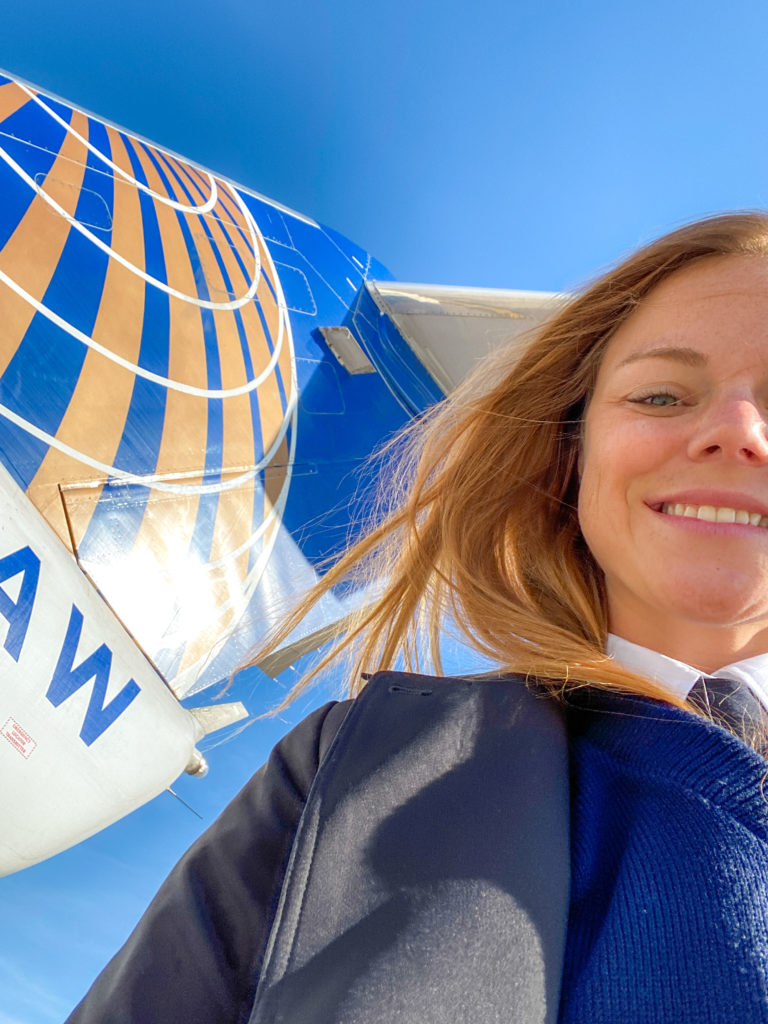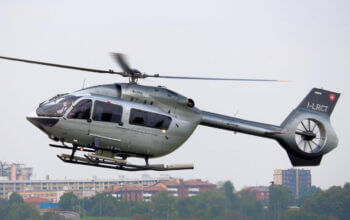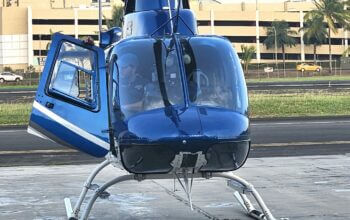Estimated reading time 22 minutes, 21 seconds.
Editor’s note: Jamie Ingall is a Canadian pilot who moved to the United States two years ago. She graduated from the University of Waterloo’s geography and aviation program in 2014, and built her time in Canada flying aerial survey, swinging gear in the right seat of a PC-12, and flight instructing. She moved on to Air Georgian and flew the CRJ-200 for a few years before the U.S. aviation industry piqued her interest.
My now-husband, Trevor, had wanted me to move to the U.S. for a while, and I kept saying, “There’s no way, I can’t work there.” Until one day, when I started cold calling regional airline recruitment departments. Eventually, I landed myself an interview at Air Wisconsin, the only company I could find that was sponsoring Canadians for work Visas. The rest is history.

With pandemic-related layoffs, I found myself taking a different path than expected. I now fly a Legacy 600 for a Part 91/135 carrier based in New York. If you want to follow my adventures, find me on Instagram @jamieingall.
Now, on to the details.
The following is a list of detailed steps required to transfer your Canadian ATPL to an FAA ATP certificate based on my experience. However, things change. So I would recommend doing a little bit of your own research. And note that your FAA inspector may tell you something different (I had a few different answers on various requirements throughout the process).
I should also say one very important thing: In my experience — even pre-pandemic amidst a “pilot shortage” — getting legal rights to work in the United States as a Canadian citizen is not easy.
1. The basics
- Make sure your Canadian license and medical are current.
- Be 23 years of age or older.
- Speak English.
2. Get an FAA medical
Go get a first-class FAA medical certificate. It’s a very similar process as in Canada, you just have to see an FAA Aviation Medical Examiner (AME). And just like in Canada, the first-class medical is valid for a year. If you’re not planning on completing the conversion process in that timeframe, do this step a little further down the line.
Where to do it: Use the FAA “Find an Aviation Medical Examiner” website for a list of FAA examiners by location. There are a few FAA certified AMEs scattered around Canada, but a lot of people opt to do this in the U.S. due to more availability. Note: when searching, select “AME” for “Designee Types.”
Book: Once you find the most conveniently located examiner and call their office to make an appointment, you’ll be directed to make an FAA MedExpress account. This is a centralized aviation medical record system where you’ll fill in all the forms prior to visiting the office.
Cost: The cost can vary. But my AME charges about US$100 cash per year.

3. Obtain a foreign license verification letter
This is basically filling out a form for the FAA saying, “I am a legitimate pilot who is already certified in Canada, and I plan to obtain an equivalent FAA license based on that premise.” And then the FAA confirms this with Transport Canada.
This process can supposedly take up to six weeks. I have never seen or heard of it actually taking that long. (This process took four weeks for me back in 2019. And I’ve heard from others that it’s even quicker now… but maybe that’s the pandemic talking).
Filling out the form: Officially, it is FAA Form 8060 (verification of foreign license authenticity). I did this the old-school way (mailing it to the FAA). But I’m told now this is an online process done through the IACRA portal.
FSDOs: When you are filling out the form, you will probably have to specify which Flight Standards District Office (FSDO) you plan to make an appointment at once it’s time to complete the conversion. FSDO locations throughout the United States can be easily Googled. It’s very important to advise them of which location you plan to go to far ahead of time, because the FAA has a very intricate system of internal communication.
Then what? Once the FAA and Transport Canada’s bureaucratic processes do their magic, you will be notified in some manner that the verification letter has been procured. But don’t assume this means the FAA has sent it to the FSDO location that you specified earlier.
When you call the specific FSDO to make the appointment (that’s a step later in this process), make sure they have your letter on file.
One last thing to note: This letter does expire. You have six months to finish the process once you get it. (Kind of like how a Transport Canada written exam expires if you don’t finish getting the associated rating or license within that amount of time.)
For more information on the process visit this link –– all about foreign license verification.
4. Sign up for an ATP Certification Training Program (CTP)
This is a seven-to-eight-day course offered throughout the U.S. at certain authorized training centers. Since 2014, it is a mandatory prerequisite for writing any ATP Knowledge Test – including the Canadian conversion exam. In other words, anyone hoping to obtain a new FAA ATP Certificate must take this course.
It seems the idea behind this course is that it’s the best way to bridge the knowledge gap between a 250-hour commercial pilot and a 1,500-hour, brand-new airline pilot.
Prerequisites: To take the course, you’ll need: money, possibly a security clearance (see step 4.5 below), and a license. (And maybe less strict quarantine requirements, because you’ll likely be traveling.) Your Canadian ATPL will get you in, but most of your classmates will be FAA commercial licensees.
Schedule: The ATP CTP is typically run as four days (30 hours) in the classroom, and three days in the simulator (four hours FTD, and six hours Level D FFS). It shouldn’t be hard to find a course that’s convenient for you; between all the different authorized providers, there are probably several courses each month.
Providers: A list of authorized schools can be found on the FAA website – but in summary, there are a handful: Embry-Riddle, CAE, FlightSafety, a selection of academies, and several airlines themselves.
Groundschool: This will be a review of “advanced” theory (think SAMRA/SARON topics), with an emphasis on human factors and other things such as MELs, operational control, etc.
Simulator: This part is actually pretty awesome. The course gives pilots who are accustomed to flying light aircraft the opportunity to train in a low-jeopardy environment using larger/more complex simulators. (I was in a Falcon, and some of my classmates were in a Hawker or an Airbus.) It offers some pilots exposure to things they may not have seen: heavy automation, high altitude weather, high altitude operations/stalls, upset prevention/recovery in a jet, etc.
Cost: I’ve seen the course listed as low as US$3,499, but have also heard it can cost almost double that. Pre-pandemic, when the airlines were hiring every 1501-hour pilot with a pulse – most had contracts with ATP CTP providers and would send all their ATP-less new hires on the company’s dime. I was lucky enough to take advantage of this and not pay for my course.

4.5. Get TSA approval… maybe?
I’m going to explain this step, because I’ve heard and read that many schools require this prior to taking the ATP CTP course. I will say that at CAE I did NOT require this clearance for ATP CTP (but DID need it for an E145 type rating course shortly thereafter). Either way, this is good knowledge to arm yourself with because, I assume if you’re reading this, you’ll eventually be going through a type rating course in the U.S. — and you’ll need to do this.
What is it? It’s a Department of Homeland Security (DHS) and Transportation Security Administration (TSA) approval program for foreign students to approve them for flight training in the U.S. At most training centers, the sim portion of the ATP CTP qualifies as “flight training”.
How to apply: Visit the official DHS/TSA foreign student website, register for an account, and apply for training. You will need to know which flight school you’re specifically going to because they’ll have to approve your application on their end as well. At some point, you’ll be sent for fingerprints (there are authorized locations all over the U.S.).
Fee: The application fee is $130. Fingerprinting, I believe, is a separate cost of about $90.
Timeline: This can and will take six to eight weeks. Plan accordingly.
5. Prepare for the knowledge test (ACM)!
If you call it a “written exam” down here, they will look at you funny. It’s referred to as a “knowledge test.” The “Airline Transport Pilot Multi-Engine Airplane Canadian Conversion” exam (otherwise known by test code as the “ACM” exam) is a 60-question exam with a passing score of 70 percent. To take this exam, you’ll need: your Canadian ATPL and your ATP CTP graduation certificate.
Studying: The ATP CTP does NOT prepare you for the exam. Now – I’m not going to sit here and write in a reputable aviation publication that I strolled in without studying, and then barely passed with a 72 percent. That would be unprofessional. But if I were to provide advice, it would be to buy the software or a book and learn all the intricate differences in airspace, air law, and IFR procedures, so that doesn’t happen to you.
Booking: A company called PSI Exams handles the FAA knowledge test admin – and it’s awesome. Go to the website, find a convenient authorized testing center near you, book an appointment, give them a credit card, then show up with the required documents.
Cost: The written test costs about $110, plus a $65 test center fee (depending where you go).
Required documents: You know what you need to go write a professional pilot exam!
6. Make an appointment with an inspector at your FSDO
Remember your FSDO? The one you specified when you filled out form 8060 for foreign license verification? Get on the phone to make an appointment, and make sure (again) they have your verification letter. Ask for an inspector who can do a Canadian ATP conversion, and see when he or she has time. Talking to them personally on the phone is a good idea to make sure you’re not missing anything.

And if you’re wanting to go to a different branch than originally specified, you should still call the original branch and ask them to send the letter to the new branch internally.
As far as I remember, the required documents for this appointment will be:
- Passport
- CURRENT Canadian licenses and medical
- FAA medical
- ATP CTP graduation certificate
- Written exam results
- New license application form
At the appointment, you should receive a temporary paper certificate to use while you wait for the real card in the mail.
In summary:
What are the steps?
The five main things you need to do to convert your Canadian ATPL to an FAA ATP certificate are:
1. Make sure your Canadian license/medical are current;
2. Get an FAA medical;
3. Get your foreign license validated;
4. Take the ATP CTP course (potentially including a time-consuming TSA clearance);
5. Take the ACM knowledge test; and
6. Make an appointment with an inspector at an FSDO and bring required documents.
How much will it cost?
If you are paying for everything yourself, the estimated costs to convert your Canadian ATPL to an FAA ATP certificate are:
- FAA Initial First Class Medical: $200
- ATP CTP course: $3,999 to $5,999
- TSA clearance: $130 (if required)
- Fingerprints: $90 (if required)
- FAA ACM knowledge test: roughly $175
- Hotels and transportation as required
How long will it take?
Your ATP license conversion from Transport Canada to FAA will involve the following approximate timelines. If you’re in a hurry, I’d get on the items marked with an asterisk ASAP.
- FAA medical: can vary; time it takes to get an appointment and travel to the closest FAA AME
- Foreign license validation: up to six weeks *
- TSA clearance (if required): six to eight weeks *
- ATP CTP course: seven to eight days, plus travel time
- FAA knowledge test: should be able to book within a few days
- FSDO appointment: could vary greatly, but roughly one week









Hi Jamie, how can you get sponsored for job in the us once you have the ATP?
Sponsorship of foreign pilots in the USA is not a thing like it is in other countries. Almost no operator does this in the USA. For a short period, Air Wisconsin and SkyWest Airlines were offering sponsorship to a select group of pilot candidates but I think that ended after COVID hit.
Doubtless a moving target, but when I did mine a few (well, 14) years ago I didn’t have to do a course. Did have to write a conversion exam, AND having discovered that the instrument rating didn’t carry across, the FAA instrument rating exam. The bit about the instrument rating was a surprise, as I’d been quite happily exercising instrument privileges prior to that with my FAA private cert. issued on the basis of my TC license. All the other steps and hoops were pretty much the same.
Also, if you’re not planning to fly airlines, an FAA second class medical is sufficient. The main difference appears to be that an ECG is not required. Quite a few FAA medical examiners won’t do first class medicals, apparently due to perceived liability exposure.
Hello Jamie,
I was at Georgian as well on the RJ, than I went to Skyregional, on the E175 to be base in YUL. How was your experience at Air Wisconsin compare to Air Georgian, management, maintenance, and schedule wise. That was interesting to read your experience to do the conversion. I did it as soon I got my CPL, but never add the ATP.
Great write-up Jamie !
Thank you very much for the information. I am planning to initiate my license conversion soon (less than 60 days). Right now at Jazz from SKV. Thank you!
My verification letter doesn’t show my most recent medical because TC is grossly behind in processing medicals. Will the FAA accept my letter with the stamp in my booklet?
Very informative topic .My question do you have to take a checkride ? Holder of a Canadian ATPl?
Hi Jaimie,
Thank you for your article. It was quite informative. I’m a Canadian citizen with just my PPL. I would also like to work at the airlines in the US one day. Would you recommend me getting all my ratings in Canada and then applying for jobs in the US or do you think it’d be a good idea to get the TSA approval to do my training in the US? Basically my questions is do you think I’ll have a higher chance of getting a job in the US if I do my training in the US?
Secondly, do you think 35 is too old to start a career in aviation if my goal is to command a wide body aircraft such as a 787 or 777?
I wish somebody had answered your question as I am in the same position and same age. Did you get an answer yet to that question somewhere else?
Is there any study material you used to start/ prepare for the written portion?